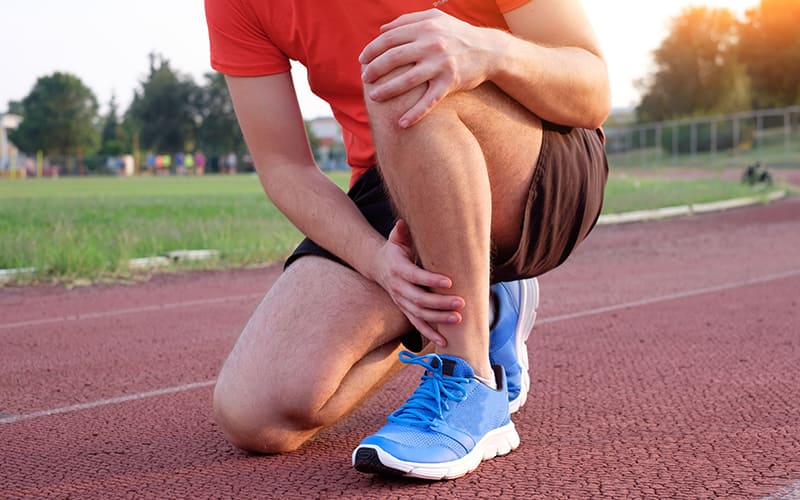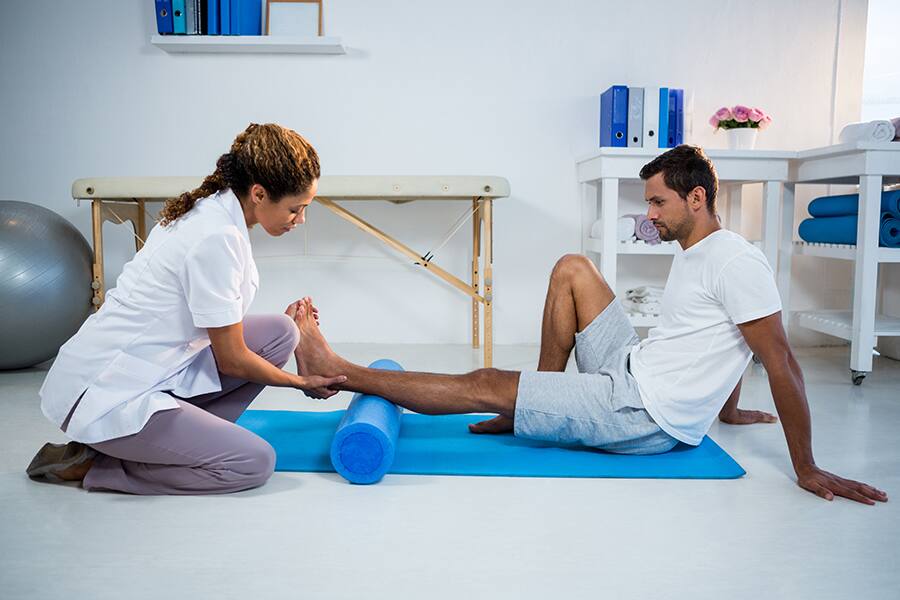Transitioning Back to Training After Injury
by John Hansen
 Injuries are a common and negative aspect of triathlon training and racing. They can sideline you for weeks, sometimes months. With proper recovery protocols, however, you can transition back to full training and racing. There are several considerations when returning to training in order to prevent injury relapse and make your transition back to normal training productive:
Injuries are a common and negative aspect of triathlon training and racing. They can sideline you for weeks, sometimes months. With proper recovery protocols, however, you can transition back to full training and racing. There are several considerations when returning to training in order to prevent injury relapse and make your transition back to normal training productive:
- Avoid dramatic changes in volume and intensity.
- Allow the injury to heal completely.
- Stay consistent with training, avoiding long, 2-3+ week breaks.
- Engage in an all-body dynamic stretching routine prior to every strength and/or high intensity workout.
- Follow a slow warm up of at least 5-10 minutes prior to any swim, bike or run workout.
- Engage in yoga or an all-body static stretching and rolling, stick and/or myofascial release routine after every workout.
- Engage in an all-body strengthening routine 3+ times a week.
- Avoid lifestyle situations that may re-aggravate a recent injury – examples: aggressively participating in sports that your body is not conditioned to support, sitting or standing for prolonged periods, walking or climbing stairs in excess, lifting heavy or awkward objects, etc.
- Videotaping - videotaping can help you make form or technique changes once you return to full training and you don’t feel any lingering effects of the injury that might alter your form. Videotaping your technique, especially while swimming or running, may uncover form flaws that may have contributed to the injury. This is valuable information for recovery and injury prevention.
Beyond these general return-to-training measures, there are specific elements to consider if an injury occurs in the key phases of training: base, build and competition. Please note: these elements are dependent on how severe the injury was. More severe injuries require longer recovery periods and a more conservative approach. It also assumes that you have medical clearance and/or are finishing physical therapy but will follow at-home therapy recommendations, allowing you to return to training.
If the injury occurs in the base phase, you stand the best chance of returning to normal training and having minimal effect on your season. Most injuries in this phase are mild to moderate and are caused by training volume, not intensity, so the severity is lessened. Key considerations when returning to training in this phase include:
- Alter training surfaces and terrain – ease back into training by running on softer surfaces and limit the amount of hill training (run and bike) early in this phase. Gradually reduce but don’t eliminate softer surface running and slowly increase the amount of hill training.
- Rebuild volume modestly – since each situation is unique, there is no specific protocol to follow, but use a 40-20 rule as a conservative guide. Start out with a training volume that is 40% of the volume you were at prior to the injury and add 20% of the new volume every 1-2 weeks. For minor injuries, this may be too conservative, and for more severe injuries, it may be too aggressive, but it can be a good starting point. In addition, since volume is the focus during this phase, reducing intensity may not be necessary.
- Walk-run protocols – for more severe running-specific injuries, consider a more conservative approach given the impactful nature of running. Start with 2-3 minutes of running and 1-2 minutes of walking and limit the workout to 15-20 minutes. Each week, add 1 minute of running and reduce the walk by 30 seconds. Keep at least 30 seconds of walk for every run segment. Once you reach 10 minutes of running per 30 seconds of walking, you should be able to run the entire workout.
- Trainer workouts – using a trainer for bike workouts adds stability and may be necessary to avoid the unpredictability of riding outdoors, especially after a severe and/or upper body injury.
- Strength training – general strength and/or dry land swim training can be a good transition back to training. Note: if strength training was the root cause of the injury, avoid or minimize those exercises that led to the initial injury until completely symptom-free. You may need to follow other recovery elements such as managing volume and intensity.
- Equipment adjustments – Make the following equipment adjustments as early as possible in this phase to allow your body to adjust to the change(s):
- Bike fit – Having a well-fit bike has several positive implications related to most joints in the body including wrists, neck, shoulders, hips, knees and ankles. It also affects your lower back, hamstrings, calves and Achilles. The fit may address the injury itself such as moving the cleats on your shoe and/or raising/lowering the seat if you had a knee injury. Use a professional bike fitter for this option.
- Running orthotics – if orthotics are recommended to you, get these as early as possible. You must adjust to your new running biomechanics before increasing training volume and intensity.
- Continue to see a PT for follow up and progression checks – I often recommend having periodic appointments with your PT to ensure you are maintaining proper rehabilitation protocols, especially if returning from a chronic injury.

If your injury occurs in the build phase and is either mild or moderate, you should be able to return to normal training with minimal effect on your racing season. If the injury is more severe, it may affect early-season races. Some considerations regarding your racing schedule may need to be made. Key considerations when returning to training in this phase include the following:
- Strength Training – heavier lifting and/or plyometric workouts, which put a lot of strain on your body, are often a part of this phase. Depending on the severity of the injury, you may need to return to lifting by using lighter weights and more reps.
- Moderately rebuild volume and intensity – many factors affect how aggressively you return to normal training including the severity of the injury, the length of this phase, when races are scheduled, and more. Follow the same 40-20 guide mentioned earlier if a conservative approach makes sense and the injury is more severe. Sometimes, a more aggressive approach may be required, but build volume to at least 75% of normal before adding lower levels of intensity.
- Equipment adjustments – Make the following equipment adjustments as early as possible in this phase to allow your body to adjust to the change(s):
- Bike seat position – height and forward/back – only minor adjustments based on the bike fit in the base phase. Consult with your bike fitter prior to making any adjustments.
- Running shoe wear and tear – due to training volume, running shoes may need to be replaced. A good rule of thumb for shoe replacement: if the shoe has 300-400 miles of use.
- Reduce the use of swim paddles/buoys – due to the overall volume and/or transition to higher intensity, reduce the use of paddles, even if they are used sparingly.
If the injury occurs in the competition phase, you should be able to return to normal training. However, it will likely have a pronounced effect on your racing season depending on several factors, including the severity of the injury and how long of a race season you have scheduled. Key considerations when returning to training in this phase include the following:
- Re-adjust racing schedule – it may be necessary to find races later in the season that allow you to rebuild fitness in order to meet your desired racing goals.
- Moderately rebuild volume and intensity – like the build phase, many factors affect how aggressively you return to normal training, including the severity of the injury, the length of this phase, when races are scheduled during this phase, and more. Follow the same principles outlined in the build phase unless a more aggressive approach can be tolerated. Don’t get so aggressive that you reinjure yourself – there’s often a thin line between getting reinjured and resuming normal training. Day-to-day adjustments may need to be made. This is a very vulnerable stage for reinjury due the sense of urgency races create.
- Equipment adjustments - equipment adjustments are only advised in extreme circumstances at this point of the season. If they must be made, they should be very minor and following the advice of your bike fitter.
A productive return to training is possible when you follow a well-thought-out transition plan that is progressive in nature, not too aggressive, and incorporates the proper elements mentioned above.
Don’t get so aggressive that you reinjure yourself – there’s often a thin line between getting reinjured and resuming normal training.
One final thought: the most vulnerable time for reinjury is when you feel normal as you return to training. Feeling normal in the early phases of recovery can be misleading since your volume and intensity are typically reduced dramatically. You may be anxious to resume normal training, but your body is often not ready. It’s important as an athlete to be aware of your body and be able to read what it’s telling you with respect to your transition back to training.
John Hansen, USA Triathlon Level II, USA Swimming Level I and USA Cycling Level III Certified coach, Folsom California. Hansen has an MS in Exercise Physiology and previously worked at the UC Davis sports performance lab for five years. Hansen currently coaches the UC Davis Collegiate Club Triathlon team. He also has his own coaching business, primarily coaching long-course athletes, 70.3 and 140.6. Visit HansenMultisport.com or email john1hansen@sbcglobal.net.
The views expressed in this article are the opinion of the author and not necessarily the practices of USA Triathlon. Before starting any new diet or exercise program, you should check with your physician and/or coach.